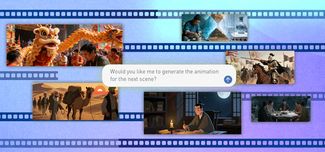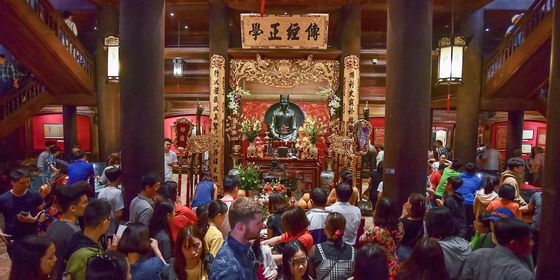An intrepid tale of sweaty cheese, stolen slippers and the joy of pig guts
It was when my mother tried to smuggle a large block of English cheddar cheese into China for me that I realized the extent of her misconceptions about the country. “Don’t you get sick of eating rice all the time?” she and other members of my family would repeatedly ask when I returned home every year. “They eat monkey brains over there don’t they?” my cousin chipped in with a smirk.
It took three years to convince my mother to visit. Intrepid traveler though she is, there was still something off-putting about Asia—“soggy toast,” “the stifling heat” and “a lack of sit-down toilets” to name but three.
After negotiating her way through customs—despite (to the evident amusement of the customs officials) the discovery of a rather sweaty lump of cheese, leaking Earl Grey teabags and other supposedly edible gifts—my mother and I were joyfully reunited. We soon jumped on a train to Guizhou, that mysterious, off-the-beaten-track province I’d always wanted to visit. Ethnic tribes, soaring waterfalls, spicy delicacies and terraced paddy fields were surely going to broaden her horizons…and be an adventure for both of us.
 “Where is this place?” my mother asked as we pulled into yet another dusty, nondescript station. “Which province are we in now? Have you booked our hotel in Guiyang? Where are we going after Guiyang?” She stared at me, bright-eyed, from across our berth. “Do you think these buns have any filling inside? These slippers are great—do you think they’d mind if I took them off the train with me? Why don’t they have pictures of the food on the restaurant car menu? Why’s that man wearing his pajamas on the train? Can you ask that man to talk more quietly on his cell phone?”
“Where is this place?” my mother asked as we pulled into yet another dusty, nondescript station. “Which province are we in now? Have you booked our hotel in Guiyang? Where are we going after Guiyang?” She stared at me, bright-eyed, from across our berth. “Do you think these buns have any filling inside? These slippers are great—do you think they’d mind if I took them off the train with me? Why don’t they have pictures of the food on the restaurant car menu? Why’s that man wearing his pajamas on the train? Can you ask that man to talk more quietly on his cell phone?”
I love my mother, and admire her willingness to go places others wouldn’t dream of venturing, especially when her best backpacking days took place in the sixties. But after a few hours in our private berth, the seemingly incessant stream of questions was starting to grate a little.
It was price worth paying to squeeze in a bit of comfort before diving into unfamiliar territory. Unlike Beijing, Guiyang—the capital of Guizhou, a far-flung province in the southwest of China—isn’t exactly the most international of cities. With a population of a mere 4 million (compared with Beijing’s almost 20 million), Guiyang is one of the few urban centers in the region. It would serve as the ideal home base for our travels in Guizhou, perhaps the most unspoiled region left in China, renowned for its natural beauty, rich ethnic culture and ancient sites.
In the late afternoon, we pulled into Guiyang station and disembarked with two pairs of slippers secreted inside my rucksack. My mother and our helpful carriage attendant had formed a great relationship, despite the fact that neither spoke a word of the other’s language, and the farewell was a fond one. Everyone seemed to like her, even if they were berated for not having photos on their menu or talking too loud on their mobile phone.
Along with its central location, Guiyang is known for two things: its natural sites and its food. Up at dawn the next day, we took advantage of both. We started our day with an early morning stroll up to Qianling Park (黔灵公园 Qiánlíng Gōngyuán), a vast, tranquil reserve outside the city center, which includes mountains, forests, the famed Hongfu Temple (弘福寺 Hóngfú Sì) and even a zoo. As I had suspected, it was also the perfect place to people-watch, which, since arriving in China, had become one of my mother’s major hobbies. She watched transfixed as Guiyang’s early risers performed their tai chi, synchronized flag waving, and all manner of other Chinese exercises.
Outside the entrance to the park, a range of small restaurants offered a cornucopia of Guizhou delicacies, with rows of bubbling pots sending clouds of steam into the air. This was our chance to sample the local cuisine, which is known for being spicy, salty and savory. We took a seat and I ordered two bowls of changwang noodles ( 肠旺面 chángwàngmiàn) and a cup of hot water for my mother’s obligatory Earl Grey teabag. Changwang noodles—a Guiyang specialty—are noodles made of eggs and flour, cooked with chang (pork intestines) and wangzi (pork blood) soup. Supposedly, every bowl contains an upwards of 20 ingredients and spices, including scallions, pig intestines and crispy fried meat.
My mother—who is used to toast and marmalade in the morning—was not impressed. I finished both bowls, grabbed a compensatory sweet potato off a nearby vendor and we were off.

Our travels were filled with savory delights, but it wasn’t until near the end of our trip, when we landed in the nearby town of Kaili (凯里), that we had the chance to sample one of Guizhou’s most famous dishes: sour soup fish (酸汤鱼 suāntāngyú). Which my mother had already decided was going to taste disgusting. Nevertheless, I was determined to break her out of her culinary safe zone.
Our taxi pulled up outside a busy-looking eatery, complete with hordes of qipao-clad hostesses. We were ushered to a table in the center of the floor, trying to act as nonchalant as possible while the patrons stopped eating to stare at us.
This restaurant’s menu had pictures, which endeared it to my mother. I ordered the sour soup fish, my mother ordered some beef rice noodles and we split a bowl of rice. Despite her best efforts, my mother loved every mouthful. “OK, but I’m still not eating those spicy snail things outside our hotel,” was her way of admitting that there was actually more to Chinese food than Peking duck.
Guiyang makes for a gentle introduction to the varied charms of Guizhou, but the main attractions are to be found in the province’s hinterland. It was time for a minibus ride to the province’s premiere attraction—Huangguoshu Waterfall (黄果树瀑布 Huángguǒshù Pùbù).
Located in the eponymous national park just southwest of Anshun (安顺) city, Huangguoshu is named after the local yellow fruit trees, whose fragrant blossoms decorate the nearby area every year. It’s also one of the largest waterfalls in East Asia. From May to October, when a brimming river plunges 74 meters into Rhinoceros Pool, the thundering Huangguoshu is an awe-inspiring sight.
As our minibus pulled into the parking lot, my mother and I could already see huge clouds of spray and hear the roar of the plunging cascade.
Up close, the waterfall was huge, majestic.
“It’s a little better than Cautley Spout,” said my mother comparing it to England’s own famed chute.
There’s more to Huangguoshu than just one big waterfall. After making our way back to the park entrance we grabbed a taxi for a short trip to the Tianxingqiao Scenic Area (天星桥 Heavenly Star Bridge), named after a slab of stone which forms a natural bridge in the center of the park.

Though my mother was less impressed than I’d hoped by either Huangguoshu or Tianxiangqiao, she was taken in by the scenery we passed on our van ride to the national park. Eyes glued to the window, my mother marveled at the karst scenery, pointing out a succession of farmers and water buffaloes in every paddy field we passed. “It’s just like the pictures,” she kept repeating with a contented smile.
The next destination on the itinerary was Kaili (where my mother was won over by the sour soup fish), a couple of hundred kilometers to the east of the capital. One of the town’s main attractions is the city’s Sunday market, centered around the side streets near the main bus station.
Selling a cornucopia of local produce and arts and crafts, this bustling bazaar was still in full swing when we arrived in mid-afternoon. As we wandered around the side streets it was hard to tell who was more curious—the pasty foreigners with their outsized rucksacks, or the colorfully dressed Miao and Dong ethnicities, peddling silks, batiks, silver jewelry, and huge mounds of fruits and vegetables. I guess not many foreign tourists had rolled into town with one of their inquisitive parents before.
My mother was taken with the elongated ear lobes of many of the women in the market. These she proceeded to check out at close quarters, much to the hilarity of everyone concerned. “Doesn’t that hurt?” my mother asked a couple of women, pulling her face into a pained look. They simply laughed and went back to inspecting my mother’s lily white skin, which was now showing the very faintest signs of a tan.
As usual, she was charming the pants off the locals without a smidge of Chinese. I even had to drag her away from a garrulous taxi driver one day as they chatted (or rather, made noises and gesticulated) about the lovely string of beads hanging from his rear view mirror. “He seemed like a nice man,” she said. “Chinese people are so friendly—they seem to respect old age a lot more here. You should take note, young man.”
A few more days in Guizhou and it was time to return to Beijing. After scouring the boutiques, bazaars and markets of Kaili and Guiyang, my mother had chosen possibly the worst souvenir in the entire history of tourism—a dilapidated straw broom that was on the verge of falling to pieces.
“Perfect for sweeping the wooden floors of my cottage,” she pronounced. By the time our train arrived back in Beijing Station, the offending item was little more than a jumble of dried grass in the bottom of her rucksack. At least we had a large collection of free slippers in compensation.
Like the article? You can buy the entire of the Women Issue in our store.











